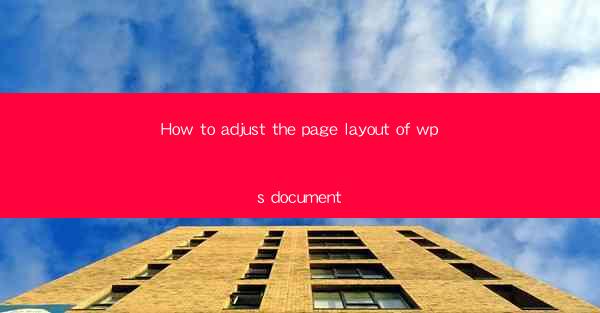
Introduction to Page Layout in WPS Document
Page layout is a crucial aspect of document creation, as it determines how your content is presented. In WPS Document, you have the flexibility to adjust the page layout to suit your needs. Whether you are working on a report, a presentation, or a simple letter, understanding how to manipulate the page layout can greatly enhance the readability and overall appearance of your document.
Accessing the Page Layout Menu
To begin adjusting the page layout in WPS Document, you first need to access the page layout menu. This can be done by clicking on the Page Layout tab at the top of the ribbon. This tab is typically located on the right side of the ribbon, just below the Home tab. Once you have accessed the page layout menu, you will find a variety of options to customize your document's layout.
Changing the Page Size
The first step in adjusting the page layout is to determine the size of your page. WPS Document offers a range of standard page sizes, such as A4, Letter, and Legal, as well as custom sizes. To change the page size, click on the Page Setup button within the page layout menu. From there, you can select a pre-defined size or enter custom dimensions.
1. Click on the Page Layout tab.
2. Click on the Page Setup button.
3. Select Custom Page Size from the dropdown menu.
4. Enter the desired width and height in the respective fields.
5. Click OK to apply the changes.
Setting Margins
Margins define the space between the edge of the page and the content. Properly setting the margins ensures that your text and images are not too close to the edges, which can make the document look unprofessional. In WPS Document, you can easily adjust the margins by using the Margins button in the page layout menu.
1. Click on the Page Layout tab.
2. Click on the Margins button.
3. Select the desired margin settings from the dropdown menu.
4. If needed, you can also manually adjust the margins by clicking on the Custom Margins option and entering specific values.
Adjusting Page Orientation
Page orientation refers to whether your document is set to be printed in portrait (vertical) or landscape (horizontal) mode. WPS Document allows you to switch between these orientations with ease. To change the page orientation, simply click on the Orientation button in the page layout menu.
1. Click on the Page Layout tab.
2. Click on the Orientation button.
3. Select Portrait or Landscape from the dropdown menu.
4. The document will automatically adjust to the new orientation.
Adding Headers and Footers
Headers and footers are useful for adding information such as page numbers, document titles, or company logos. In WPS Document, you can easily add and customize headers and footers to your document.
1. Click on the Insert tab.
2. Click on the Header or Footer button.
3. Choose the type of header or footer you want to add from the dropdown menu.
4. Once you have added a header or footer, you can click on the Header or Footer tab to customize its content.
Using Section Breaks
Section breaks are used to divide a document into separate sections, each with its own page layout settings. This is particularly useful when you want to apply different margins, headers, or footers to different parts of your document. To insert a section break in WPS Document, follow these steps:
1. Click on the Page Layout tab.
2. Click on the Breaks button.
3. Select the type of section break you want to insert (e.g., Next Page, Continuous, or Even Page).
4. The section break will be inserted, and you can then adjust the layout settings for that section.
Finalizing Your Page Layout
Once you have made all the necessary adjustments to your page layout, it's important to review your document to ensure that everything is aligned and formatted correctly. Take a moment to check the margins, headers, footers, and overall appearance of the document. If everything looks good, you can proceed to save and print your document. Remember to proofread your content as well, as changes to the page layout may affect the readability of your text.











